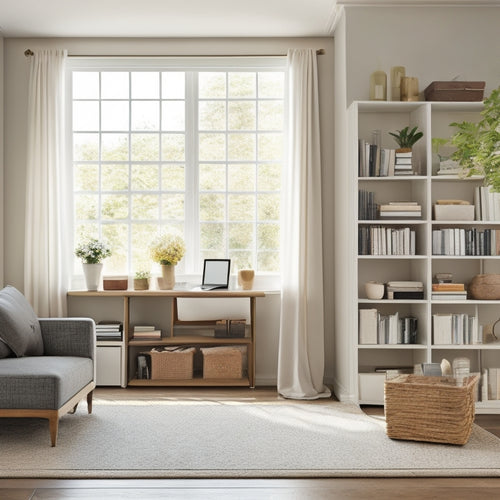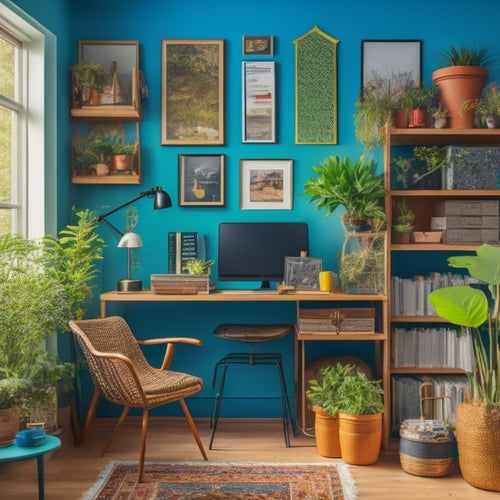
5 Essential Tips for Remote Workers' Home Office
Share
To create a productive and comfortable home office, start by designating a dedicated workspace that's ergonomic and well-lit. Invest in a desk and chair that fit your body and work style, and position them near a natural light source. Next, manage cords and wires effectively using cable ties and labels. Develop a storage system that keeps your workspace organized, and establish a daily cleaning routine to stay focused. Finally, prioritize a tidy workspace by scheduling regular deep cleans. By following these essential tips, you'll be well on your way to creating a home office that sparks motivation and efficiency – and there's even more to explore.
Key Takeaways
• Designate a dedicated workspace with an ergonomic setup, good lighting, and personal touches to boost productivity.
• Optimize your desk and chair to fit your body and work style, with adjustable furniture and a glare-free screen.
• Implement a cord management system to keep cords and wires organized, labeled, and out of the way.
• Create a storage system with designated spaces, labels, and organizational tools to keep essential items within reach.
• Establish a daily cleaning routine to maintain a distraction-free environment and schedule a deep clean weekly or bi-weekly.
Designate a Dedicated Workspace
Set aside a specific area of your home that will serve as your workspace, free from distractions and interruptions, to help you establish a clear boundary between work and personal life. This dedicated space will become your sanctuary, allowing you to focus on your tasks without being sidetracked by household chores or family members.
When designing your workspace, prioritize an ergonomic setup to secure comfort and productivity. Invest in lighting solutions that reduce eye strain and provide ample illumination. These investments will pay off in the long run, as you'll be more efficient and experience fewer physical discomforts.
Add some personal touches to make your workspace feel truly yours. Incorporate decor ideas that inspire creativity and calmness, such as plants, artwork, or a motivational quote. These details will help you feel more engaged and motivated, making your work-from-home experience more enjoyable.
Optimize Your Desk and Chair
Choose a desk that fits your body and work style, allowing you to work comfortably and efficiently. An ergonomic set up is vital to avoid straining your back, neck, and eyes. Consider investing in adjustable furniture, such as a sit-stand desk or a chair with customizable height and lumbar support. This will enable you to switch between sitting and standing throughout the day, maintaining your energy and focus.
Proper lighting is also necessary for your home office. Position your desk near a natural light source, if possible, to reduce eye strain and boost your mood. Additionally, invest in a good desk lamp to supplement natural light, especially during cloudy days or late nights. Avoid placing your computer directly under overhead lighting, as this can cause glare on your screen.
Manage Cords and Wires Effectively
To maintain a clutter-free and organized workspace, consider implementing a cord management system that keeps your cords and wires tidy and easily accessible. This won't only reduce visual clutter but also prevent tangles and knots that can lead to damaged cables.
You can use cable ties, zip ties, or velcro strips to keep cords organized and secure. Labeling each cord or wire can also help you quickly identify which one goes where.
Effective cord organization is pivotal for a productive home office. It saves you time and frustration when searching for a specific cord or trying to troubleshoot a connection issue. A well-organized cable management system also reduces the risk of electrical hazards and tripping hazards.
Invest in a cord organizer or a cable management box to keep your workspace tidy and organized. By implementing a cord management system, you'll be able to focus on your work without distractions, increasing your overall productivity and efficiency.
Create a Storage System That Works
Create a Storage System That Works
Designating a specific space for storing office supplies, paperwork, and equipment helps maintain a clutter-free workspace and reduces time wasted searching for misplaced items. You'll be more productive and focused when everything has its designated spot. To get started, assess what you need to store and categorize items into groups, such as office supplies, paperwork, and equipment.
| Category | Storage Solution | Benefits |
|---|---|---|
| Office Supplies | Organizational bins | Keeps frequently used items within reach |
| Paperwork | Filing cabinets | Stores and organizes important documents |
| Equipment | Shelves or cabinets | Protects equipment from dust and damage |
| Miscellaneous | Desk organizers or trays | Keeps small items, like paper clips or pushpins, tidy |
Remember to label each storage solution so you can easily find what you need. By implementing a storage system, you'll create a more efficient and organized workspace that allows you to focus on your work, not searching for lost items.
Establish a Daily Cleaning Routine
You dedicate a few minutes each day to tidying up your home office space to maintain the sense of organization and focus you've worked hard to establish. This daily cleaning routine will help you stay on top of clutter and keep your workspace efficient.
Start by organizing clutter hotspots, such as your desk or shelves, and put away items that are out of place. Take a few minutes to wipe down surfaces, vacuum or sweep the floor, and empty the trash. By doing so, you'll create a clean and distraction-free environment that fosters productivity.
To take your cleaning routine to the next level, schedule a deep clean once a week or bi-weekly. This will give you time to tackle more thorough tasks, such as dusting, cleaning windows, or reorganizing your storage system.
Frequently Asked Questions
How Can I Avoid Burnout While Working From Home Full-Time?
To avoid feeling drained, you'll want to prioritize "me time" by establishing self-care routines, like meditation and exercise, and schedule virtual team bonding activities to combat loneliness and boost productivity.
Can I Claim My Home Office Expenses on My Tax Return?
You can claim home office expenses on your tax return if you're eligible, but be sure to keep accurate documentation, including receipts, to prove the business use percentage of your home.
How Do I Maintain a Work-Life Balance When Working Remotely?
To maintain a work-life balance while working remotely, you'll need to set clear boundaries and prioritize time management. Create a schedule, stick to it, and learn to disconnect when work hours are over to maintain your personal life.
What Are Some Strategies for Minimizing Distractions at Home?
You'll boost productivity by setting a schedule, dedicating a workspace, and creating boundaries with family and friends. Implement time management techniques, like the Pomodoro Technique, and stay organized to minimize distractions and maximize your work-from-home experience.
How Can I Stay Connected With Colleagues and Avoid Feeling Isolated?
Did you know that 70% of remote workers feel left out of the office loop? You can combat isolation by attending virtual happy hours, participating in online team building activities, and scheduling regular video check-ins with colleagues.
Related Posts
-

10 Essential Skills for Mastering Home Organization
You're ready to take control of your space and transform it into a haven of calm and productivity. Mastering home org...
-

10 Essential Digital Tools for Small Space Living
You're looking to maximize your digital tools to minimize clutter and streamline your small space living. Start by ut...
-

3 Best Online Courses for Home Organization Skills
You're just a few clicks away from a clutter-free home and a more efficient daily routine. Three online courses can h...


